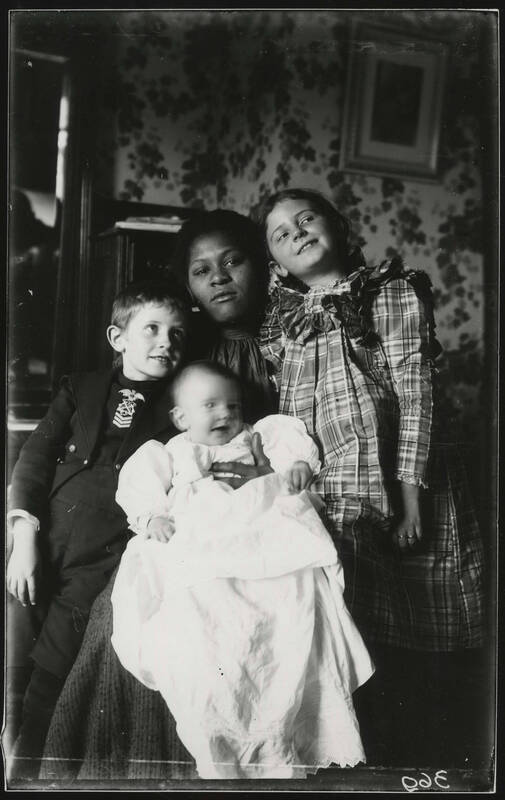Carrie Gillenwaters
Carrie Gillenwaters was an African-American woman, who migrated to Muncie with her family during the late nineteenth century. She held many jobs and positions throughout her life, including as a domestic servant, in addition to being a wife, divorcée, and adoptive mother. Learn more about her life in the video below.
This video was researched and created by Virginia Carter, Linda Laws, and Anna Osborne.

Carrie Gillenwaters with the Ryan-Marsh children, November 20, 1898. She was probably 15 years old in this photograph. Photograph by John Rollin Marsh, Marsh-Ryan Family Collection, M-369, Archives and Special Collections, University Libraries, Ball State University.
The photograph (left), which appears in the documentary above, deserves more discussion as a primary source.
Today with our unprecedented access to technology, photographs are commonplace, merely mundane. Everyone in the world can become a photographer and take a picture with a device nearly all of us carry in our pockets. We do not think much about the process, and especially much about the historical relevance of photographs, when we snap pictures.
What goes into a photograph?
Photography had only originated 60 years prior to this photograph being taken.
In addition to requiring an expensive camera and film, in the 1890s a photographic exposure needed its subjects to remain seated for a while in order to create the image. In other words, photographs require intentionality and patience. It is no surprise, then, that the baby in this photograph is blurry. This is very different from today's cameras which take pictures in an instant. When this photograph was taken in 1898, the process would have been much longer.
A photograph like this is incredibly rare because someone with the access to material and equipment went out of their way to remember their children, yes, but also to remember Carrie Gillenwaters. (The photographer was her employer and the children's father, John Rollin Marsh.) For most of the working class, and especially for working-class African Americans, both access to technology and photographers' intentionality was often lacking. Someone wanted Carrie Gillenwaters to be remembered and, fortunately for us, she has been.
To hear more about the historian's process and the methodologies used to research and create historical narratives, check out the conversation between Carter, Laws, and Osborne below.
Carrie Gillenwaters shows how women lived and worked independently at a time when divorce and single-parenthood was considered unusual in theory, if not in practice. Her story of domestic abuse and divorce, however, was, lamentably, much more common than we might think. Click on Dr. Anna Lemon Griffin to learn more about a notable, educated woman, who also dealt with these issues.
